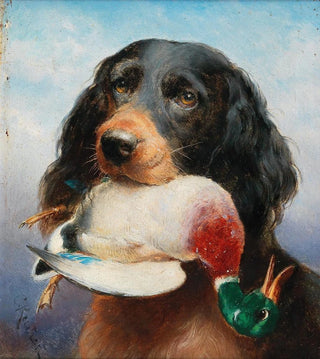Art print | Setter Gordon with mallard duck - Carl Reichert


View from behind

Frame (optional)
In the world of wildlife art, the "Setter Gordon with Mallard" by Carl Reichert stands out for its striking realism and ability to capture the very essence of nature. This painting not only evokes the beauty of animals but also highlights the intimate relationship between humans and wildlife. Through this artwork, Reichert transports us to a world where the dog, a symbol of loyalty and companionship, proudly stands alongside its prey. The viewer is invited to feel the palpable tension of the scene, while the majestic mallard, with its vibrant plumage, almost seems alive. This piece, rich in detail and emotion, embodies a true ode to the wild.
Style and uniqueness of the artwork
Carl Reichert's style is characterized by meticulous attention to detail and impressive technical mastery. In "Setter Gordon with Mallard," each feather of the duck is rendered with unparalleled precision, while the dog's coat appears almost tangible. Light plays a crucial role in this composition, subtly illuminating the forms and textures, creating an atmosphere that is both serene and dynamic. The color palette, dominated by natural tones, enhances this impression of realism. Reichert manages to establish a harmonious balance between shadow and light, bringing his subjects to life. The artwork also stands out for its ability to evoke storytelling, where each element contributes to narrating a story—the frozen moment between the hunter and his prey.
The artist and his influence
Carl Reichert, 19th-century Austrian painter, made a notable place for himself in the world of wildlife art. His work, marked by a deep admiration for nature, reflects his commitment to depicting fauna with touching authenticity. Influenced by the great masters of animal painting, Reichert developed a style that is uniquely his own, blending realism and romanticism. His passion for animals, especially dogs and birds, is evident in each of his works. As a member of the Vienna Academy of Fine Arts, he contributed to the growth of the

Matte finish

View from behind

Frame (optional)
In the world of wildlife art, the "Setter Gordon with Mallard" by Carl Reichert stands out for its striking realism and ability to capture the very essence of nature. This painting not only evokes the beauty of animals but also highlights the intimate relationship between humans and wildlife. Through this artwork, Reichert transports us to a world where the dog, a symbol of loyalty and companionship, proudly stands alongside its prey. The viewer is invited to feel the palpable tension of the scene, while the majestic mallard, with its vibrant plumage, almost seems alive. This piece, rich in detail and emotion, embodies a true ode to the wild.
Style and uniqueness of the artwork
Carl Reichert's style is characterized by meticulous attention to detail and impressive technical mastery. In "Setter Gordon with Mallard," each feather of the duck is rendered with unparalleled precision, while the dog's coat appears almost tangible. Light plays a crucial role in this composition, subtly illuminating the forms and textures, creating an atmosphere that is both serene and dynamic. The color palette, dominated by natural tones, enhances this impression of realism. Reichert manages to establish a harmonious balance between shadow and light, bringing his subjects to life. The artwork also stands out for its ability to evoke storytelling, where each element contributes to narrating a story—the frozen moment between the hunter and his prey.
The artist and his influence
Carl Reichert, 19th-century Austrian painter, made a notable place for himself in the world of wildlife art. His work, marked by a deep admiration for nature, reflects his commitment to depicting fauna with touching authenticity. Influenced by the great masters of animal painting, Reichert developed a style that is uniquely his own, blending realism and romanticism. His passion for animals, especially dogs and birds, is evident in each of his works. As a member of the Vienna Academy of Fine Arts, he contributed to the growth of the






